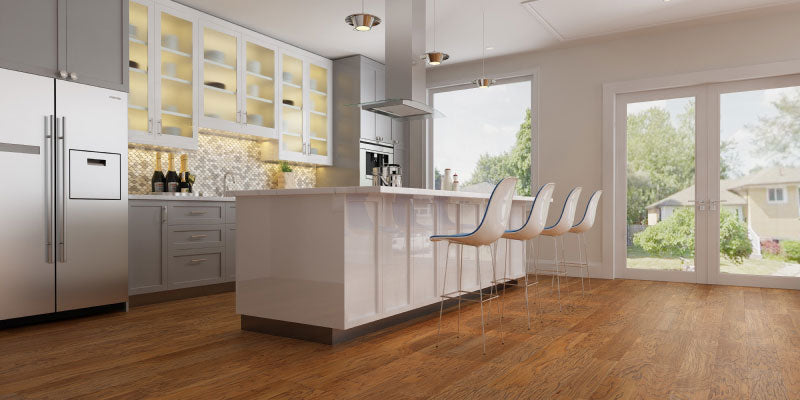
How to Fix Peaking or Buckling Hardwood Floors
|
|
Time to read 4 min
|
|
Time to read 4 min
As beautiful as hardwood floors are, they require a significant amount of care both during and after installation. Wood reacts to changes in the environment, even if that environment is your home, and its sensitivity can lead to ugly grooves, hills, and valleys undulating across your living room floor. Homeowners with wood floors are frequently faced with buckling or peaking floorboards. Although the damage appears atrocious — and costly to fix — you can easily repair the issues yourself after becoming familiar with the common causes behind it.
Peaking describes more dramatic grooves in the hardwood. The grooves rise higher, and the peaked areas involve more than one floorboard. Water damage is usually the reason for buckled floors, but mistakes during installation are frequently the cause behind peaks. Wood floors need to breathe. The humidity levels in your home naturally change with season, temperature, and weather. The correct way to install hardwood is to leave small gaps between the floorboards and around the room where the wood meets the wall. The gaps give the boards room to expand when it’s humid and to contract when it’s dry.
Without room to expand, the swelling floorboards heave upward, creating walking hazards and unsightly hills. The boards may splinter as well, particularly around the walls. Any restrictions that inhibit floating floors from actually floating pose the same problem. It’s impossible to overemphasize how important it is to leave wood floors the space they need to contract and to expand.
Before attempting to fix your much admired maple hardwood floor, it’s necessary to discover what’s causing your problem. You know the main culprits, so sniffing out the cause won’t take long. Moisture or water damage is the most likely issue, especially regarding quick changes. It doesn’t take much water exposure to buckle unprotected boards. At that point, your biggest problem involves figuring out what’s behind your moisture problem.
Peaking due to tension is distinctly different. While humidity and moisture content lead to peaking, the damage done is messier and wider spread in that it tends to affect groups of boards. Since there’s nowhere for the boards to expand, they often splinter along the edges of the room. Those signs let you know the flooring doesn’t have any personal space, so to speak.
Some buckles, grooves, and peaks are too warped or water damaged to flatten them. Replacing them doesn’t mean you have to tear up the entire floor, however. You can just remove the peaked boards and install a new section of flooring in their place. Match the hue by purchasing hardwood that’s already stained, or stain and seal it afterward.
Don’t make the same mistake twice. As you place the unblemished boards, leave tiny gaps between them. The correct spacing isn’t large; you shouldn’t see glimpses of the subfloor beneath. Each floorboard merely needs room to expand without repeating the same problem.
Whichever way you choose to remedy the warped floorboards, once the grooves are gone, and the floor is smooth again, carefully reinstall the pieces of molding. You’ll probably need to hammer it back into its proper place. Remove any nails that remain in the wood and reinstall it using new finishing nails. Take care not to splinter the molding as you return it to its proper place.
Hardwood adds value to the home and creates an elegant, warm atmosphere in any room you install it. It’s essential you maintain it properly, whether that involves humidity and temperature control, protecting the floorboards, or repairing them as soon as you see signs of peaking or buckling. If you acquire the help of a professional to install new flooring, then double-check that there are spaces between the boards and no obstructions beneath it that will interfere with the wood’s ability to expand and to contract. Whether it is your kitchen or living room floors, buckled and peaked floorboards just aren’t the best way to enjoy your pricey hardwood floor. Besides the obvious effect on appearance, such a floor is a safely risk. Now that you know what causes these issues, you should be able to avoid them. It also helps that you now know how to replace the affected floorboards.